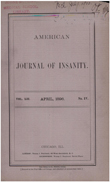Understanding the comorbidity between early-onset dysthymia and cluster B personality disorders: a family study
Abstract
OBJECTIVE: A number of studies have documented significant comorbidity between dysthymia and axis II personality disorders, particularly those grouped in cluster B. However, the nature of this comorbidity is poorly understood. The purpose of this investigation was to use the family study method to test five competing models of the comorbidity between early-onset dysthymia and cluster B personality disorders. METHOD: Proband groups consisted of subjects with early-onset dysthymia and a co-occurring cluster B personality disorder (N = 28), subjects with early-onset dysthymia without a cluster B personality disorder (N = 69), and a comparison group of subjects who had never been psychiatrically ill (N = 45). The groups were compared on rates of dysthymia with a cluster B personality disorder, dysthymia without a cluster B personality disorder, and cluster B personality disorders without dysthymia in their first-degree relatives (N = 675). RESULTS: The relatives of both subgroups of dysthymic probands exhibited higher rates of dysthymia with a cluster B personality disorder, dysthymia without a cluster B personality disorder, and cluster B personality disorders without dysthymia than the relatives of the never ill probands. In addition, the relatives of probands with comorbid dysthymia exhibited higher rates of cluster B personality disorders without dysthymia than the relatives of probands with noncomorbid dysthymia. CONCLUSIONS: This pattern of results is consistent with the notion that dysthymia and cluster B personality disorders co-occur because of shared etiological factors. This was the only one of five models of the comorbidity between dysthymia and cluster B personality disorders that was supported by the family data.
Access content
To read the fulltext, please use one of the options below to sign in or purchase access.- Personal login
- Institutional Login
- Sign in via OpenAthens
- Register for access
-
Please login/register if you wish to pair your device and check access availability.
Not a subscriber?
PsychiatryOnline subscription options offer access to the DSM-5 library, books, journals, CME, and patient resources. This all-in-one virtual library provides psychiatrists and mental health professionals with key resources for diagnosis, treatment, research, and professional development.
Need more help? PsychiatryOnline Customer Service may be reached by emailing [email protected] or by calling 800-368-5777 (in the U.S.) or 703-907-7322 (outside the U.S.).



